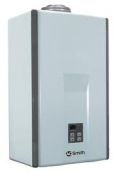Tankless Water Heaters
Today many people are choosing tankless (also called on-demand or instantaneous) gas water heaters. These are very compact and generally wall-hung. Their rated efficiency is higher than that of tank units, usually around 0.82. However, the delivered efficiency gains may be somewhat more modest in typical home use, and they can be very expensive to install in retrofit applications, requiring special ductwork and upsizing of gas lines.
Unlike conventional water heaters tankless water heaters store very little or no hot water. With tankless units, a gas burner or electric element heats water only when there is a demand for hot water. Hot water never runs out, but the flow rate (gallons of hot water per minute) is limited. Before rushing out to buy an on-demand water heater be aware that they are not appropriate for every situation. Consider the water distribution system. If the hot water use-points in a home are relatively close together with short hot water lines between them, a tankless system may work well. In many homes, water use-points are widely spaced at opposite ends of the house. If this is the case, a single tankless system with long distances between the system and the point-of-use can increase frustration. The user will have to wait through a long "slug" of cold water before receiving hot water.
With regard to electric units, residential wiring generally will not support a tankless electric water heater with large enough capacity to serve multiple uses. Smaller tankless electric units may be unlikely to meet the overall household demand. An electric “point-of-use” unit may be appropriate for small applications, such as a remote vanity or half-bath. Generally, the Title 24 code discourages the use of tankless electric water heaters when using both prescriptive and performance methods of compliance. One exception is for a residence/ADU 500 square feet or less with a point of use credit applied.

